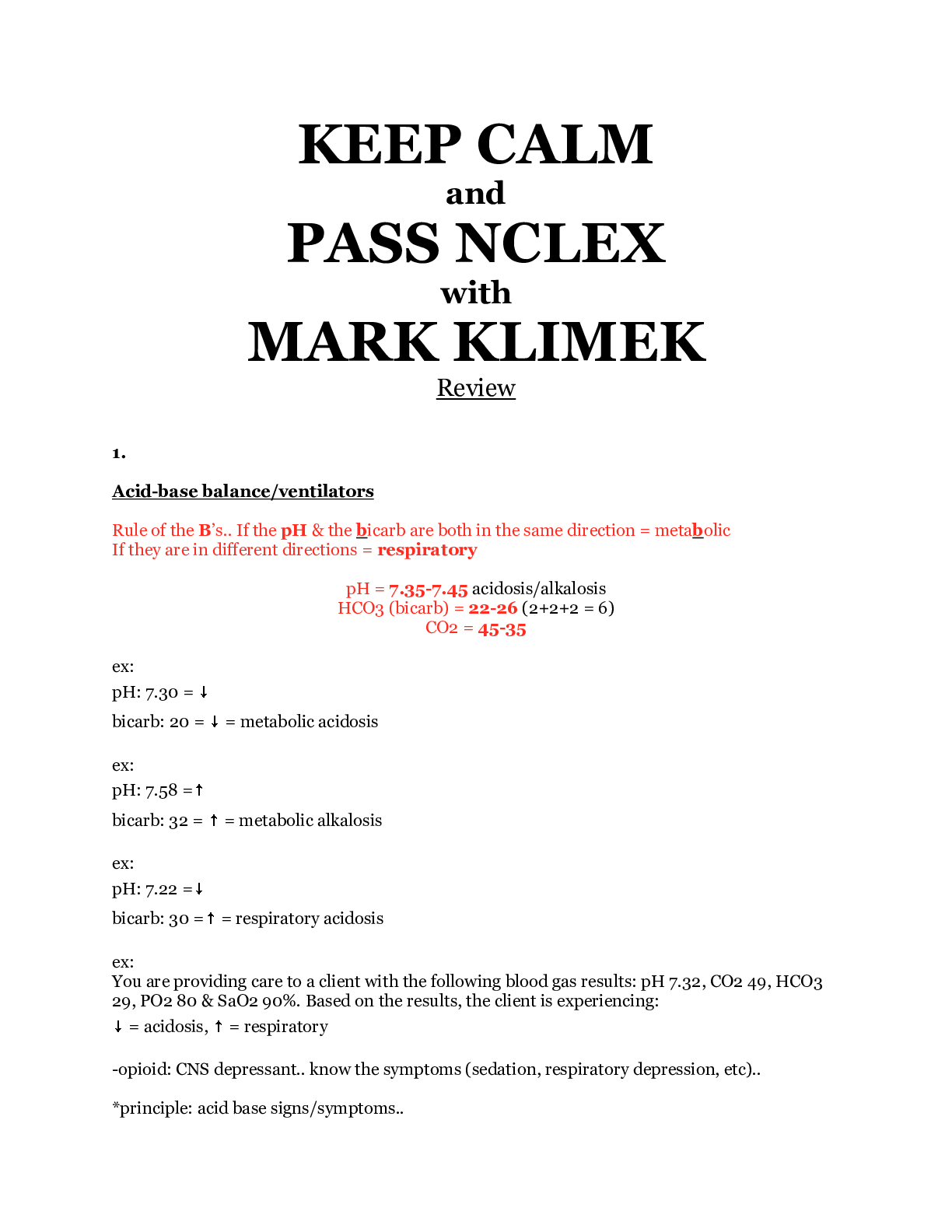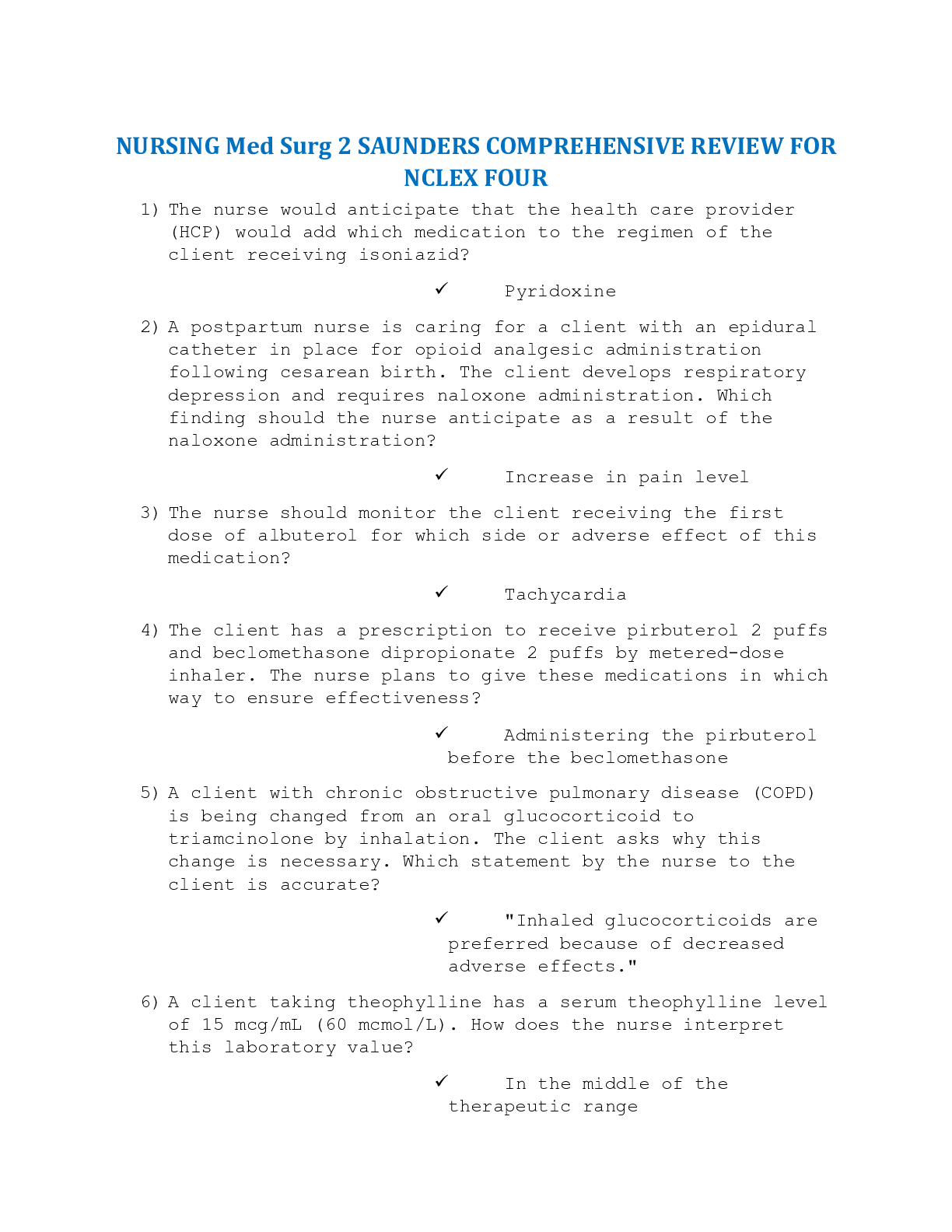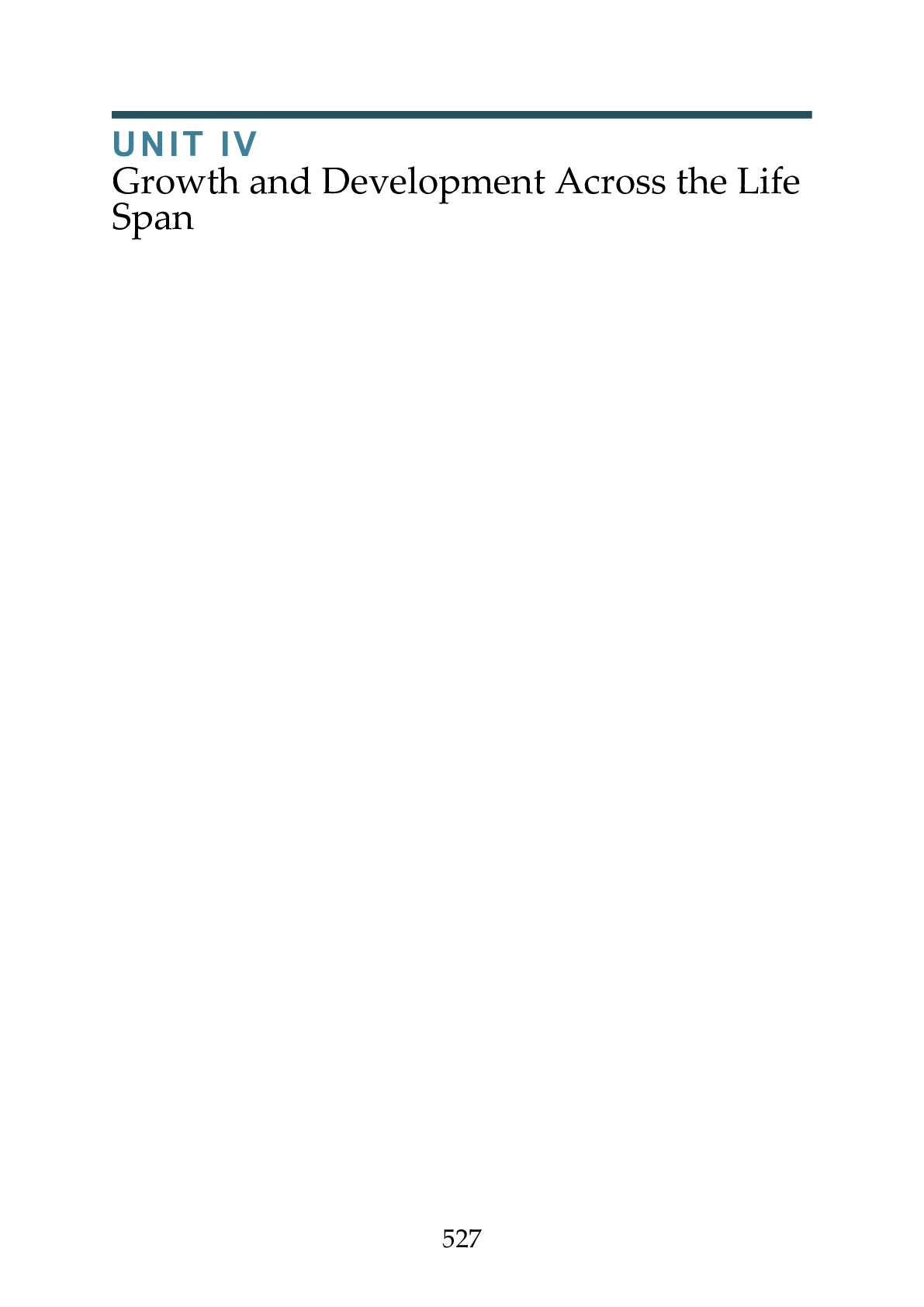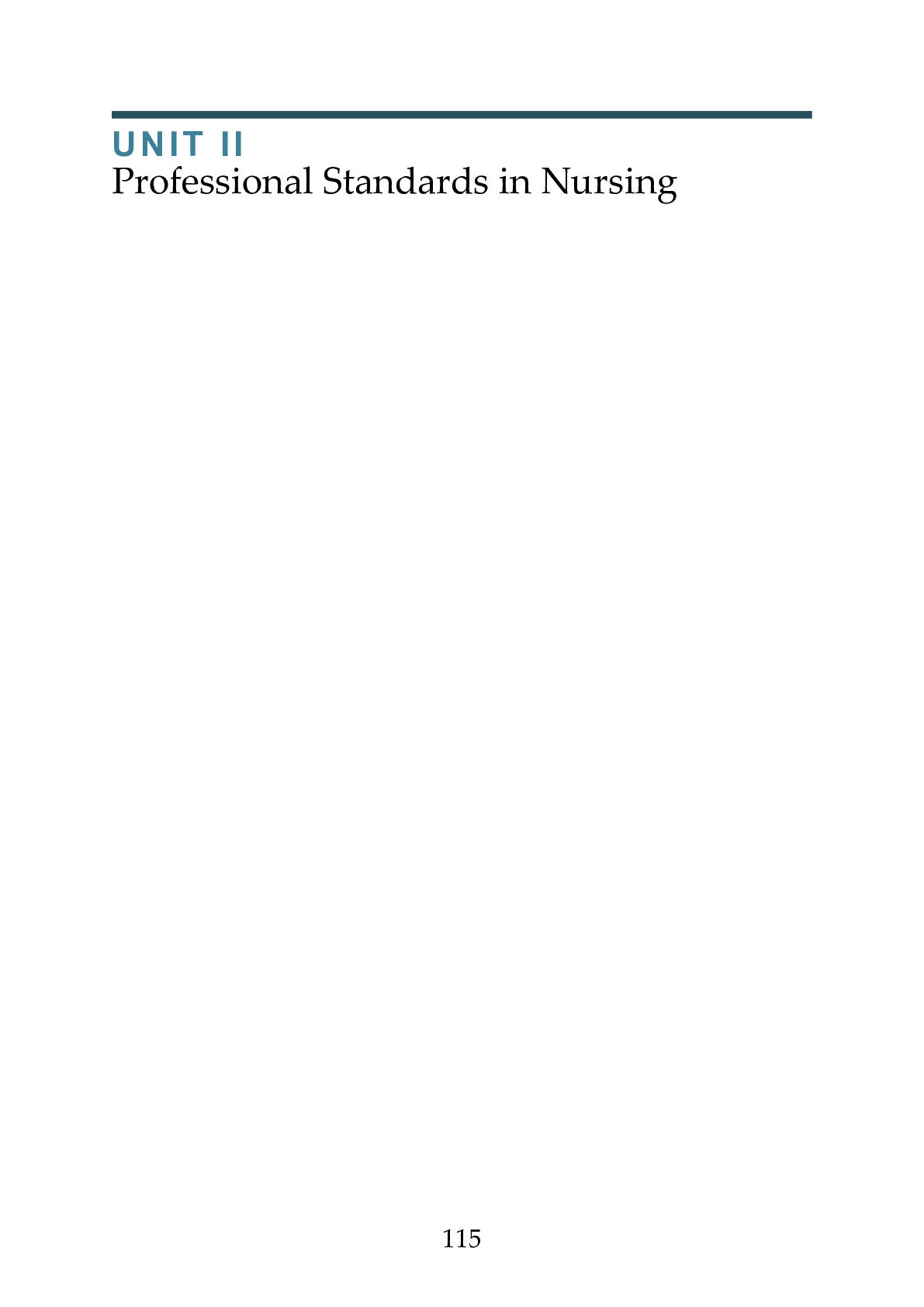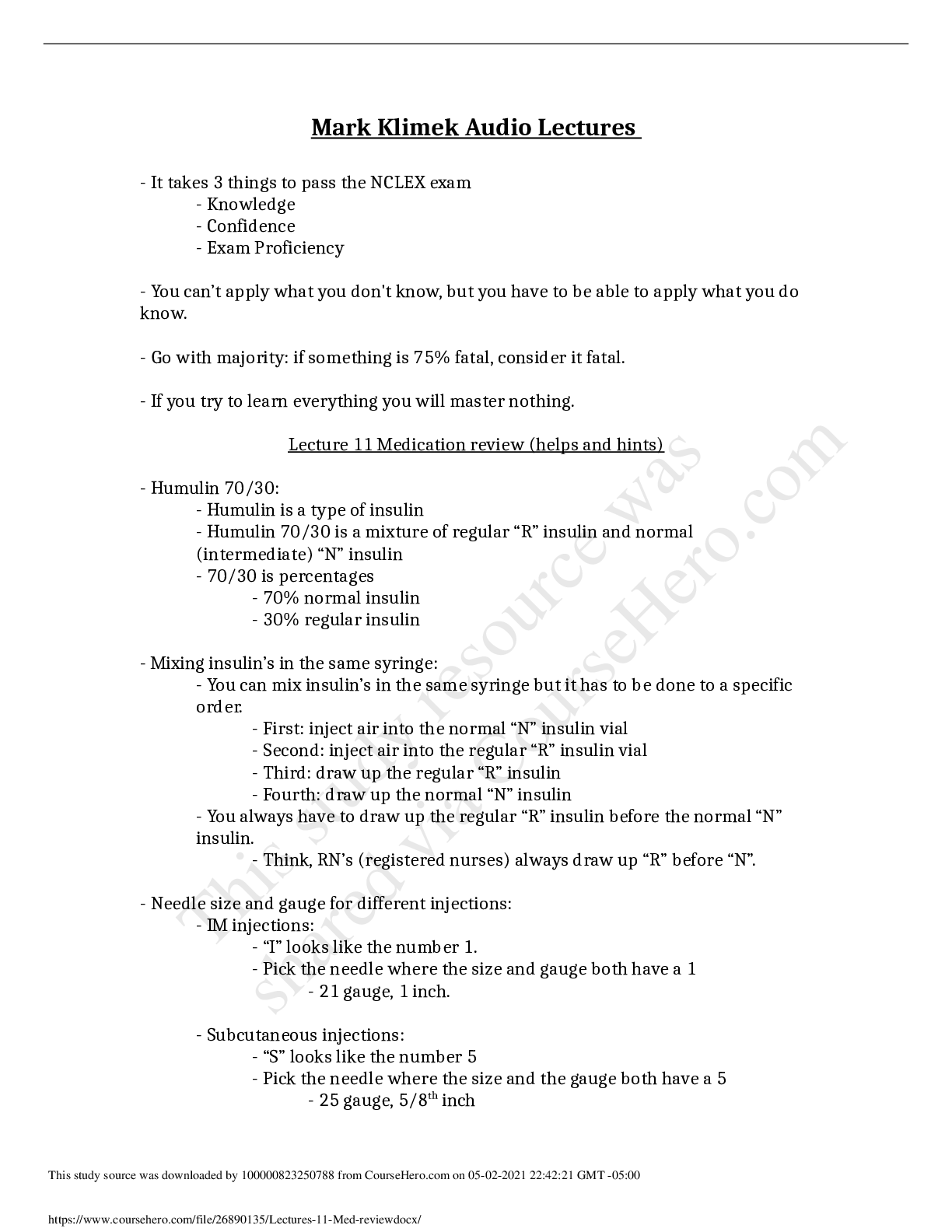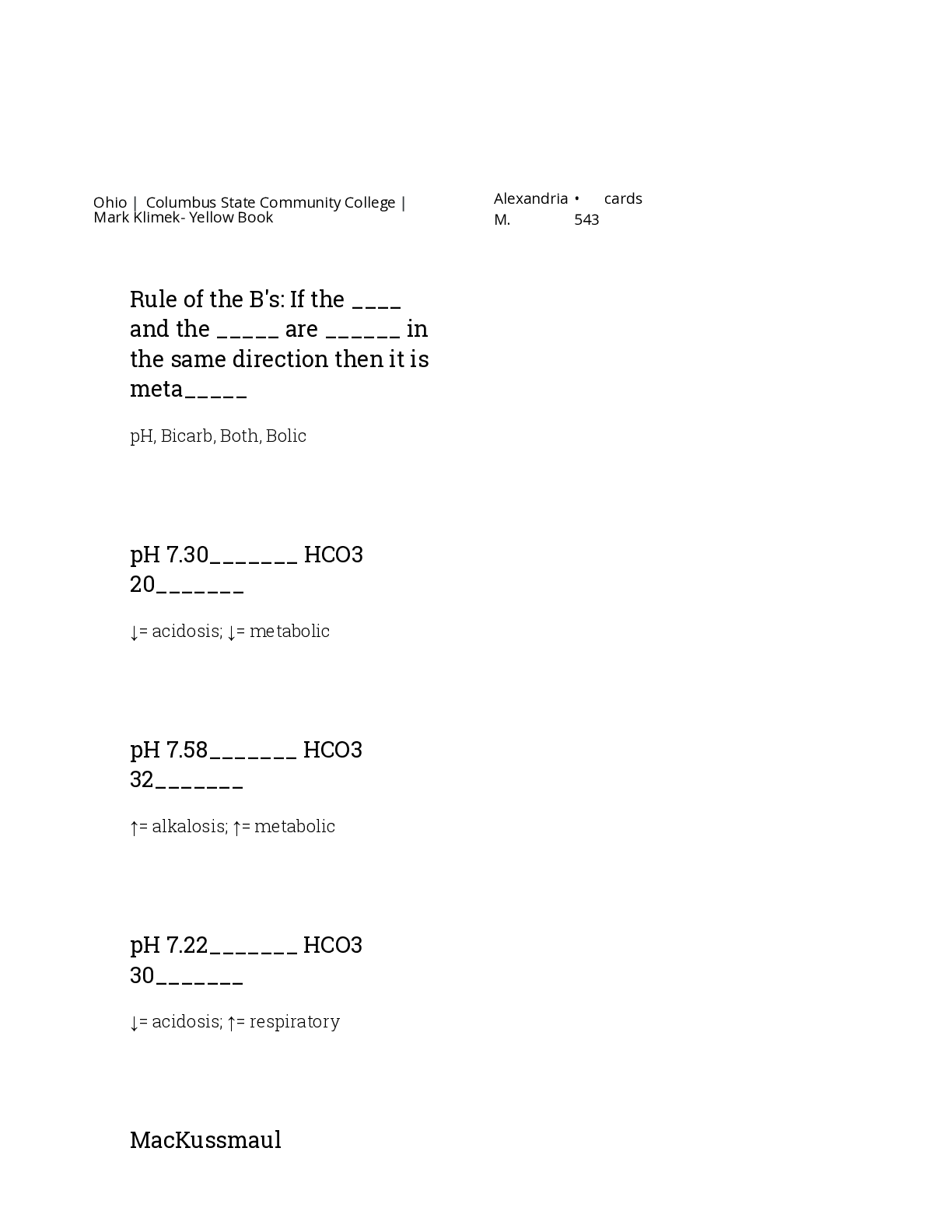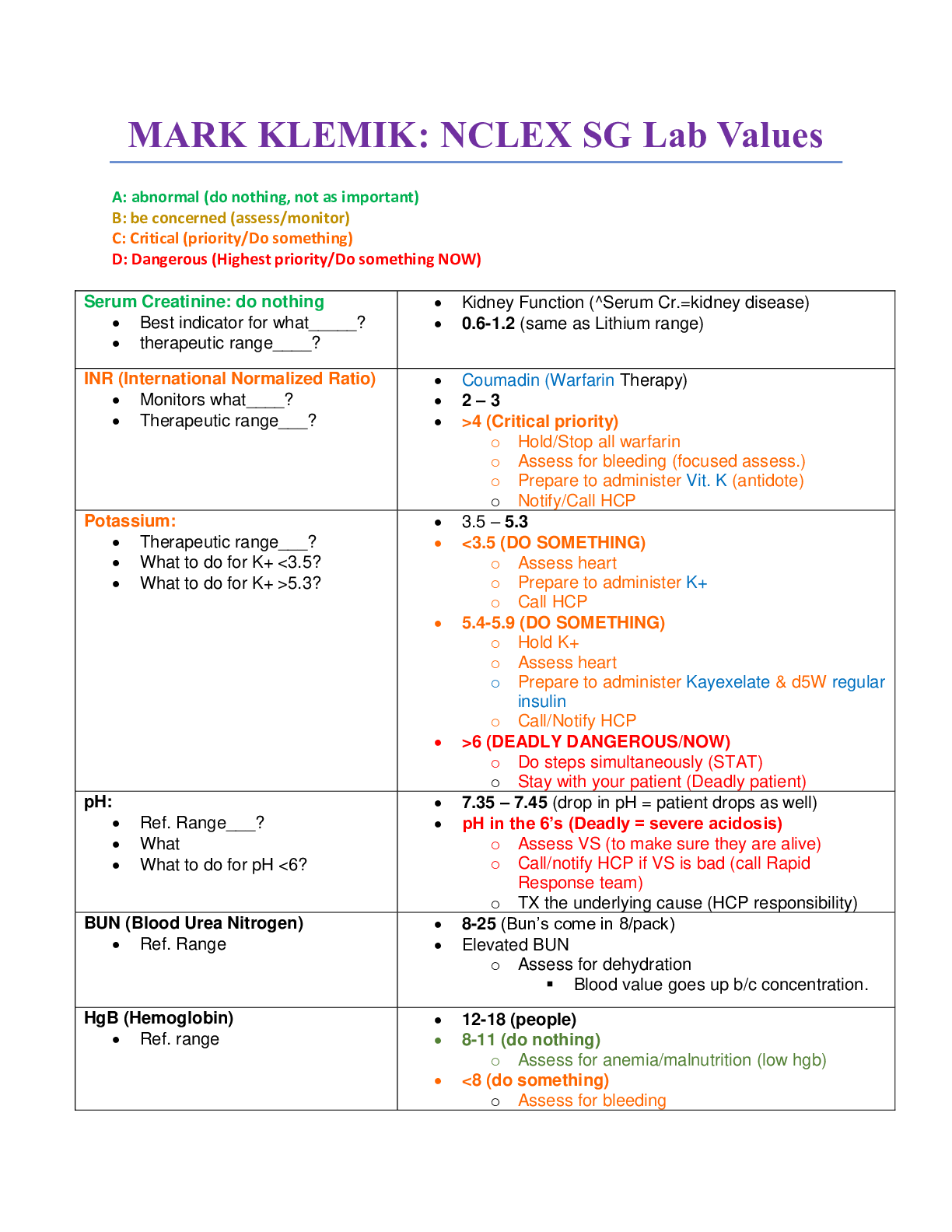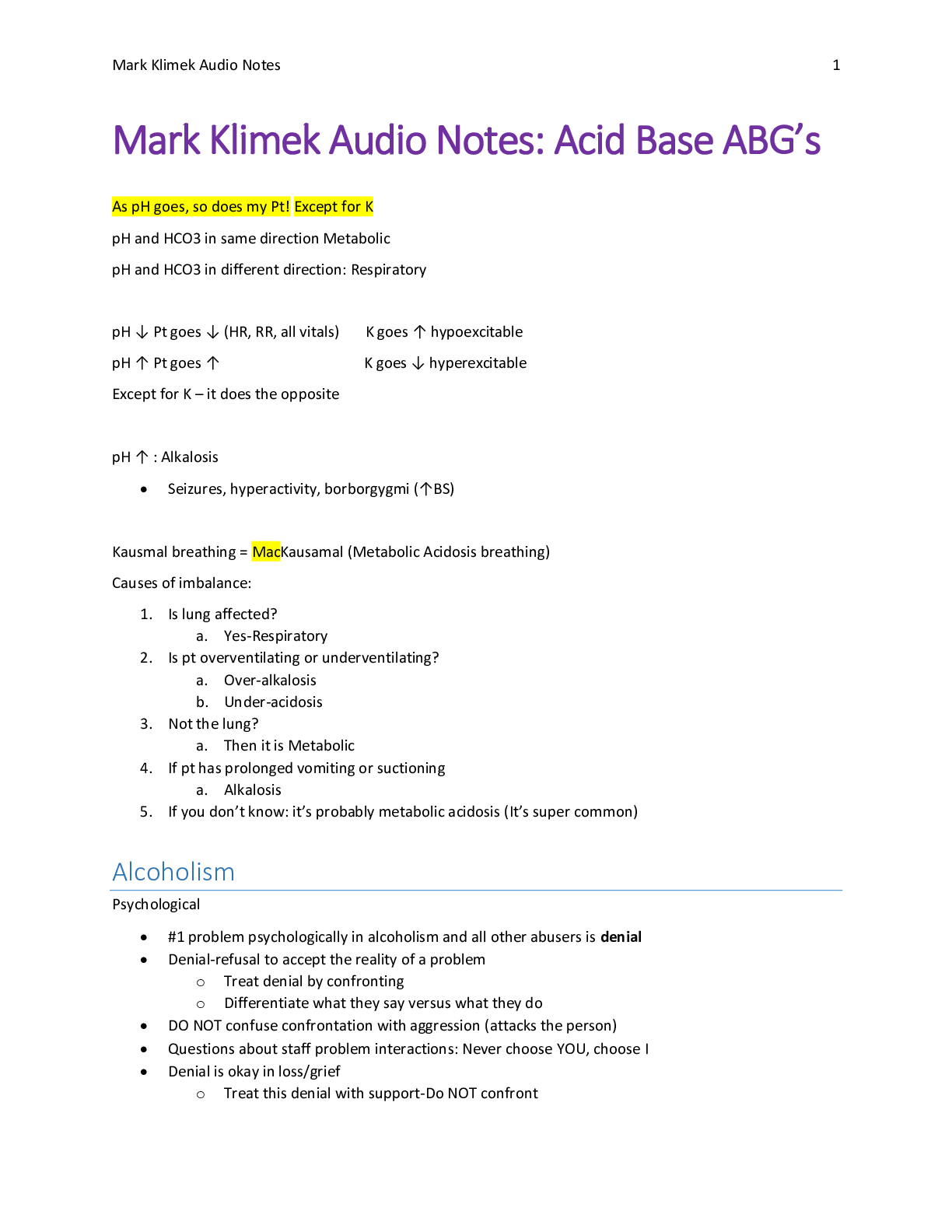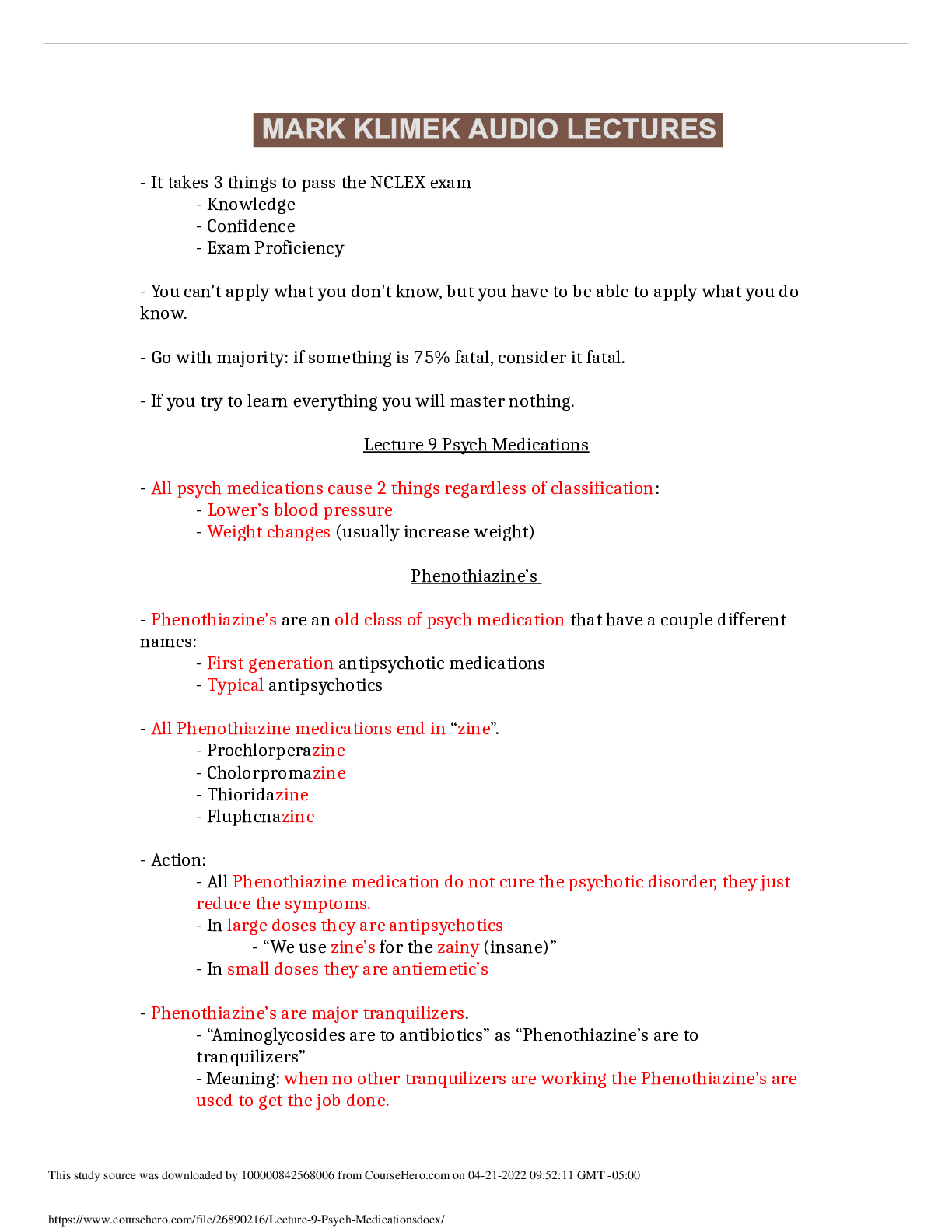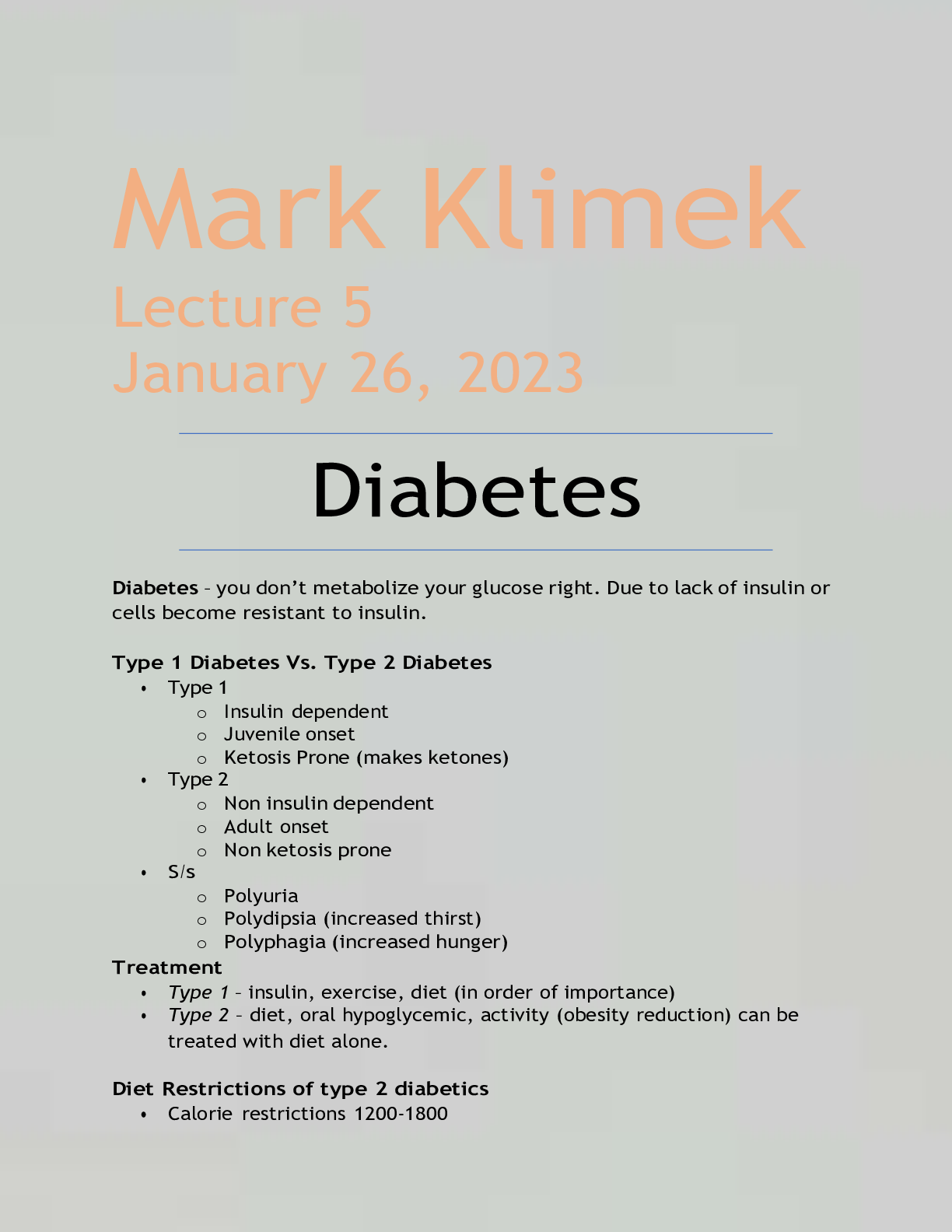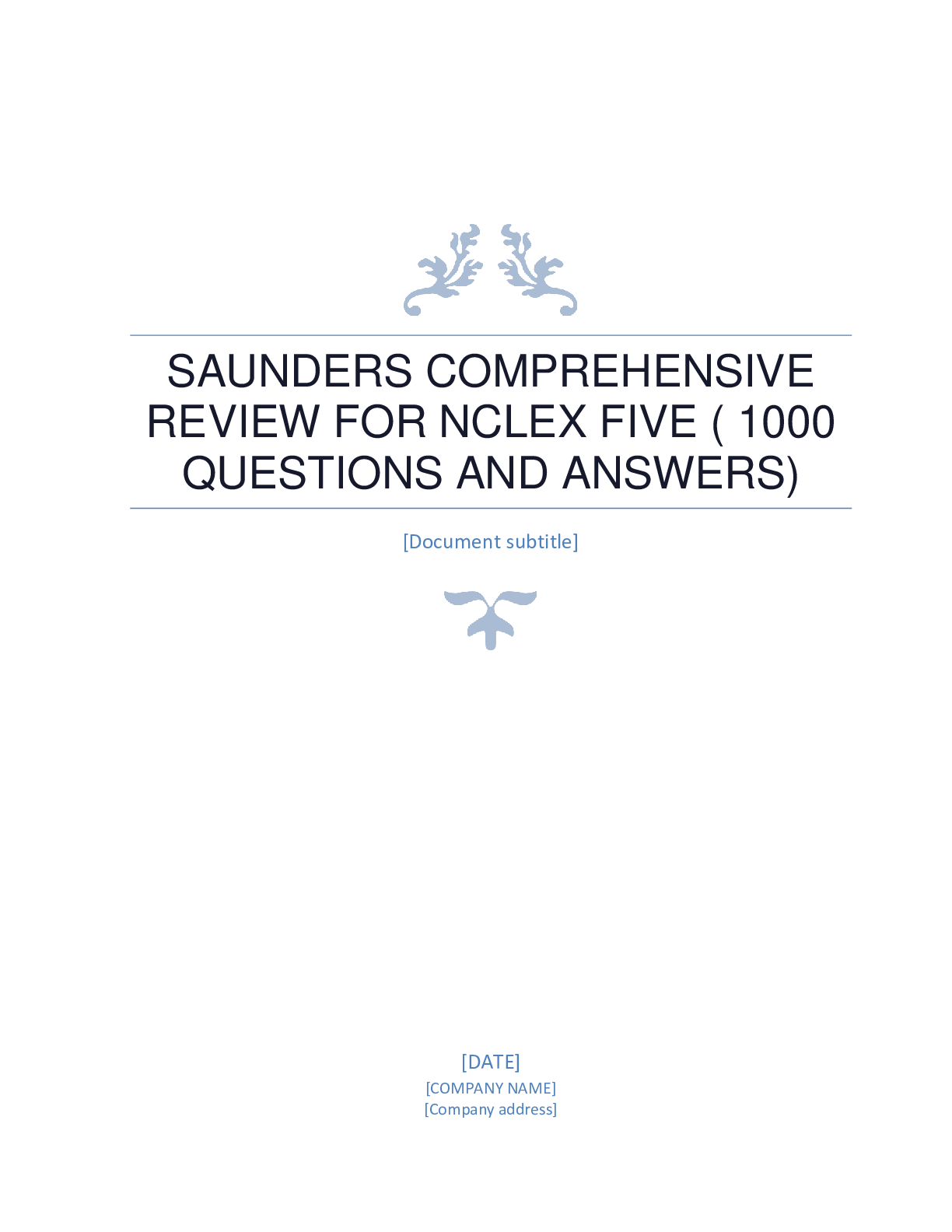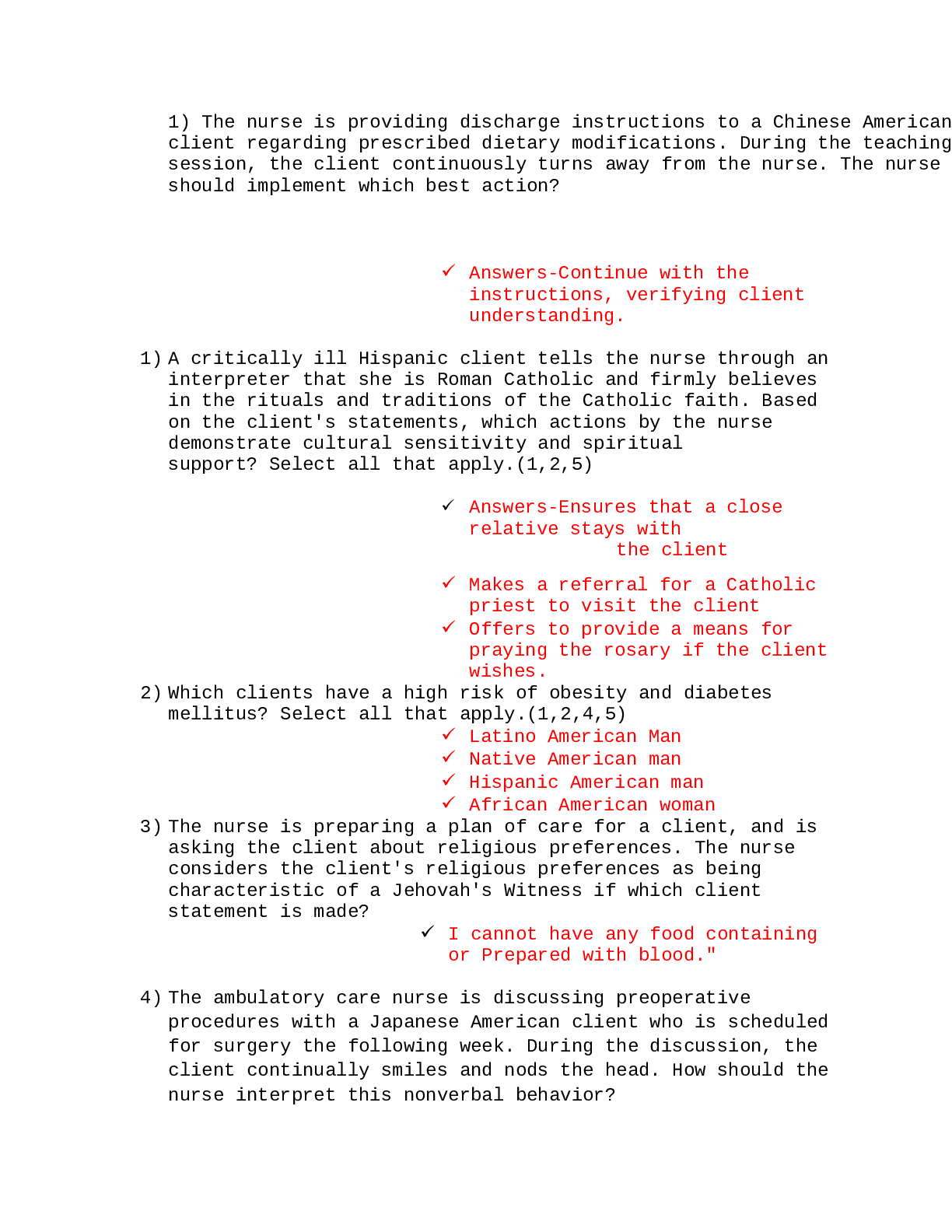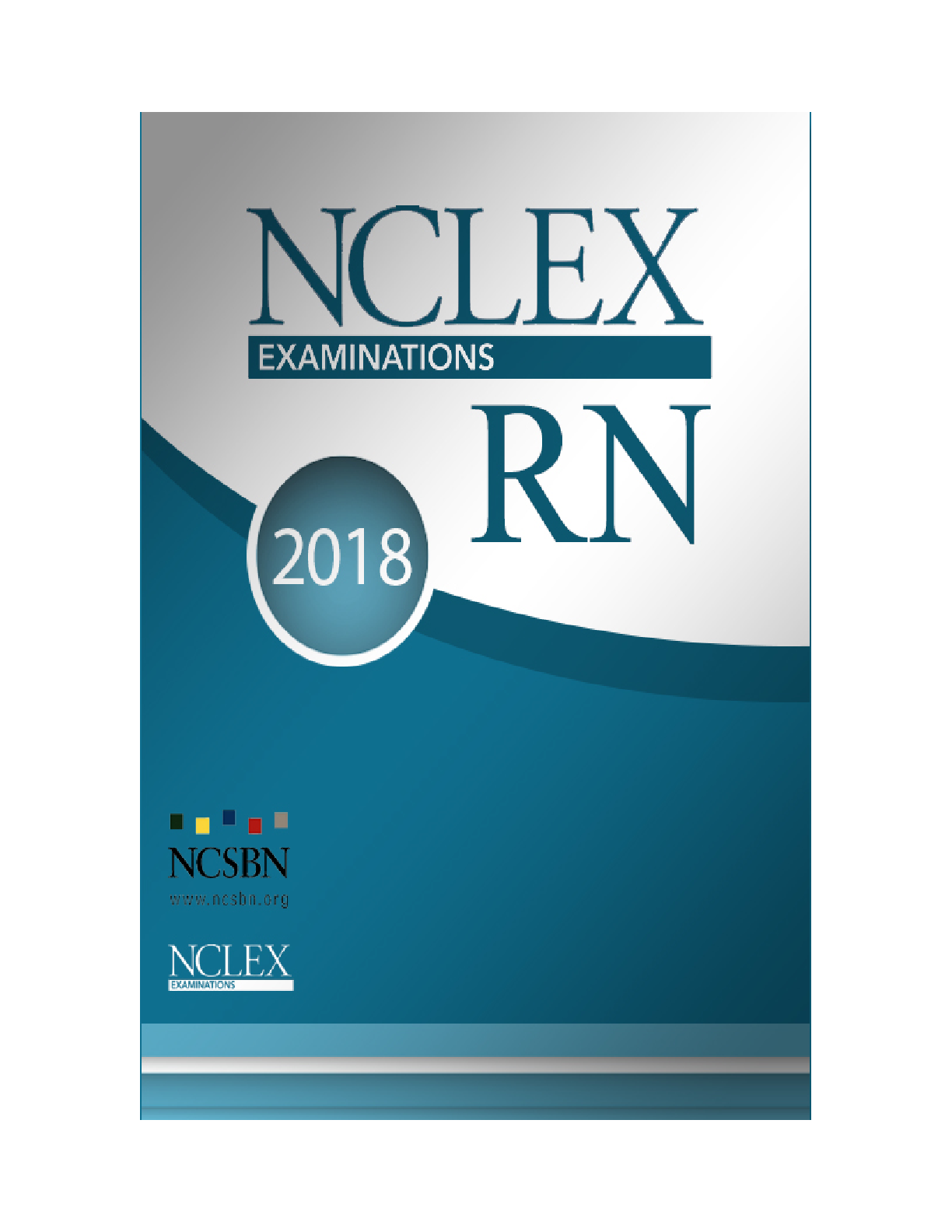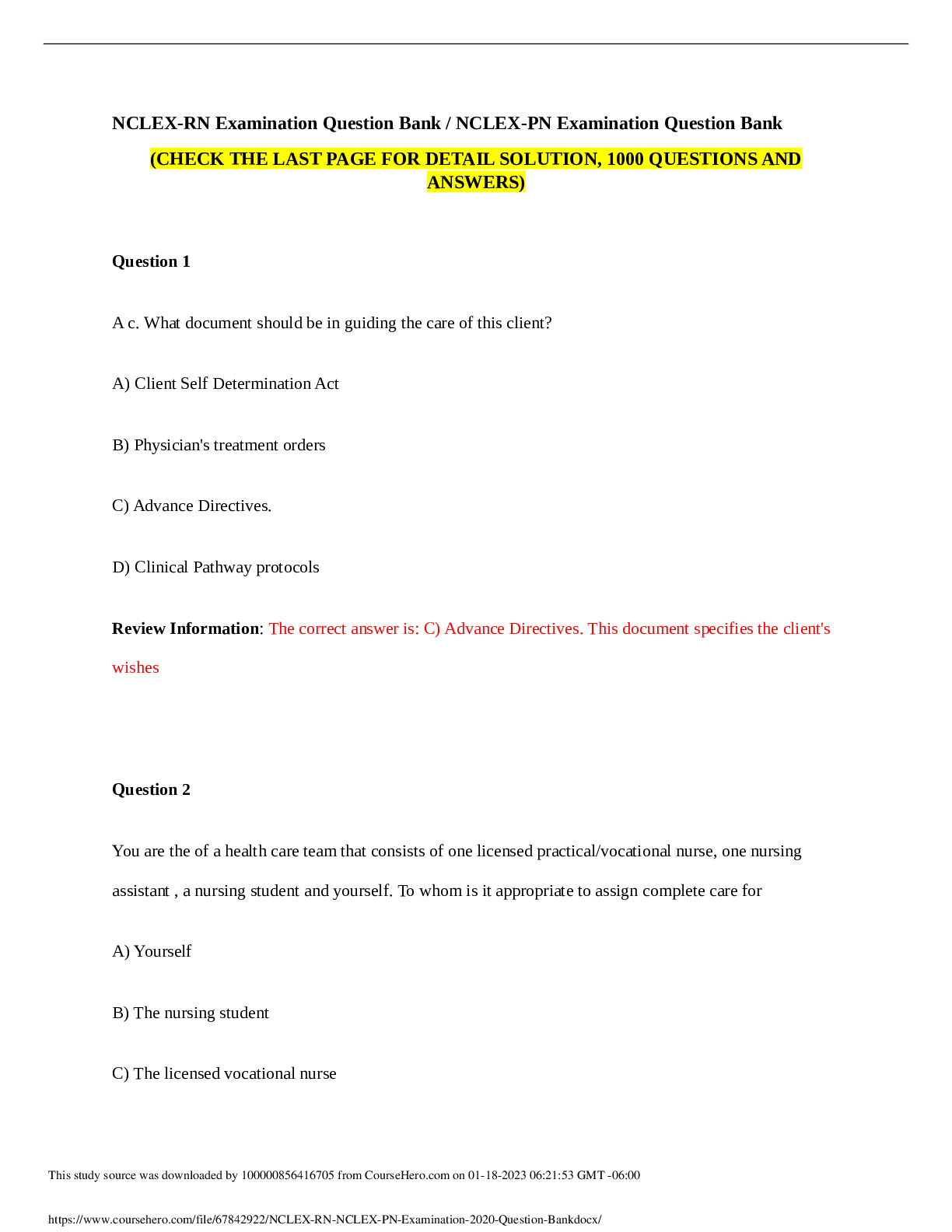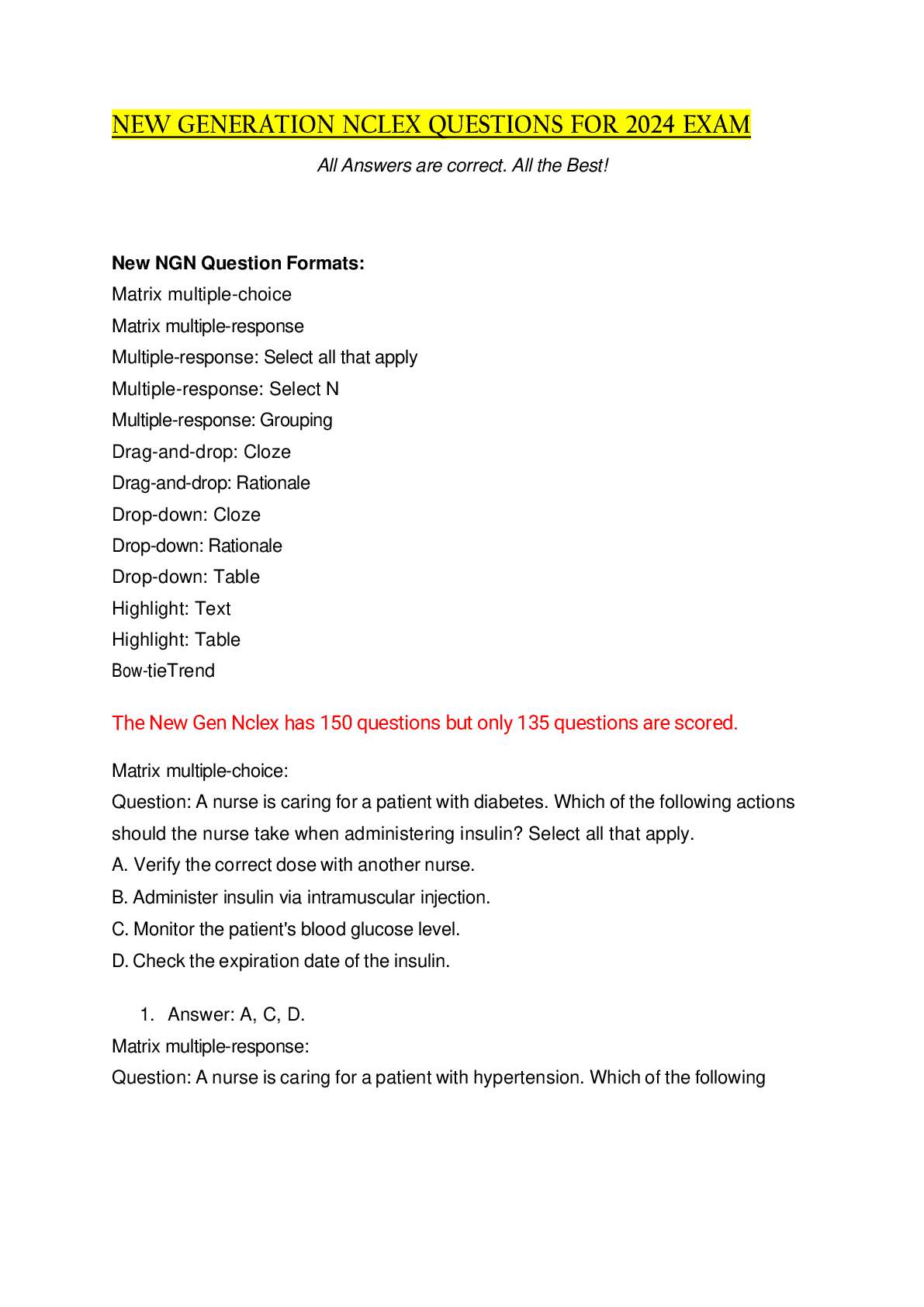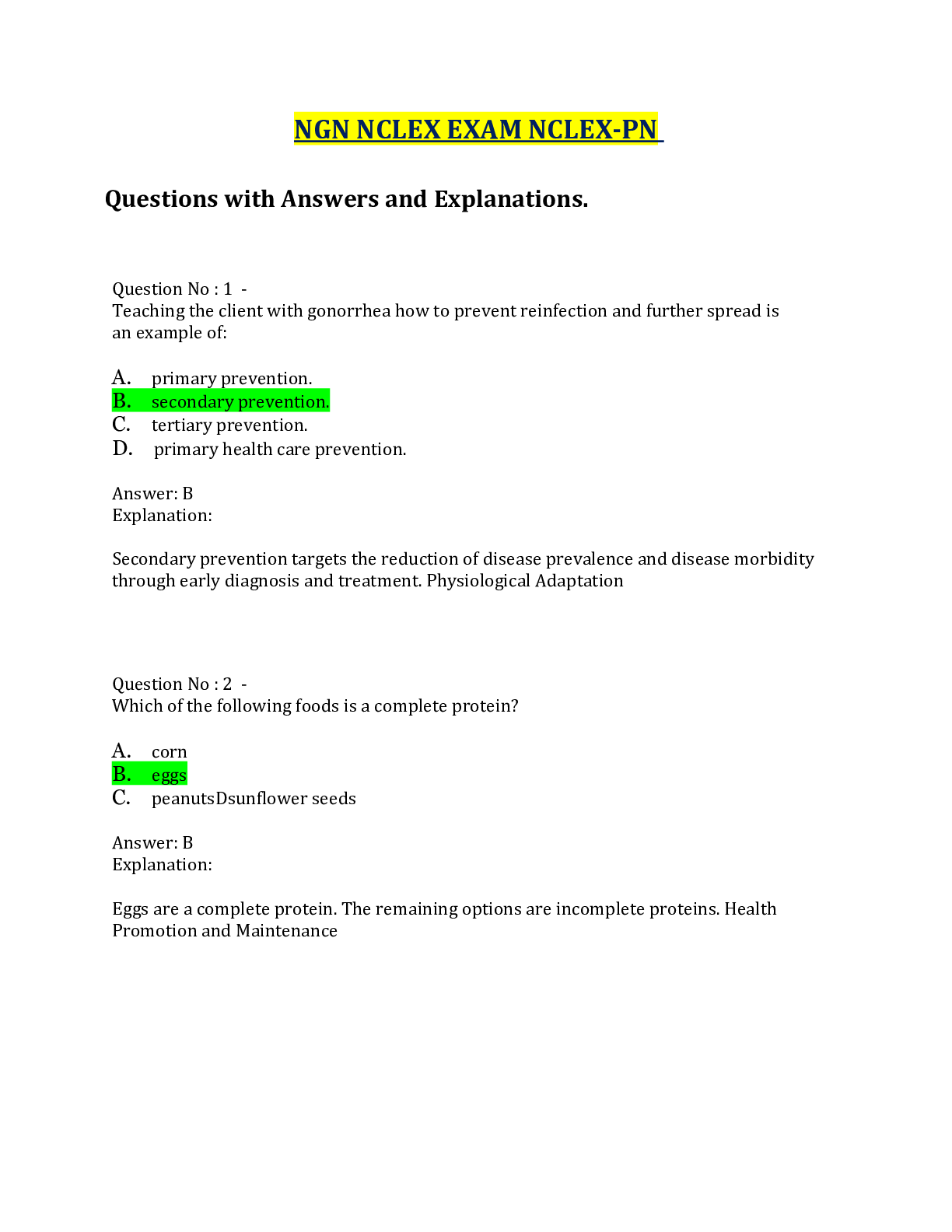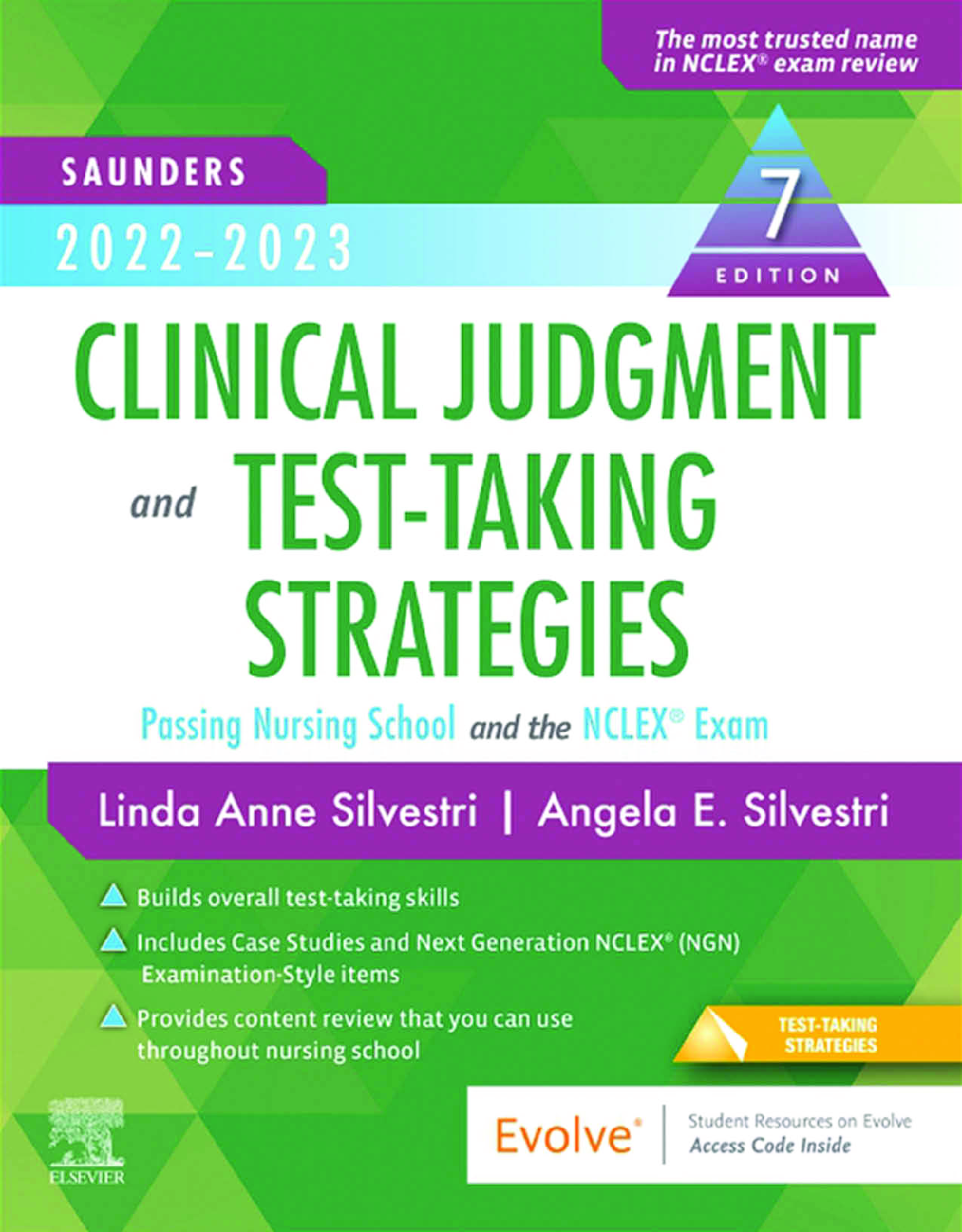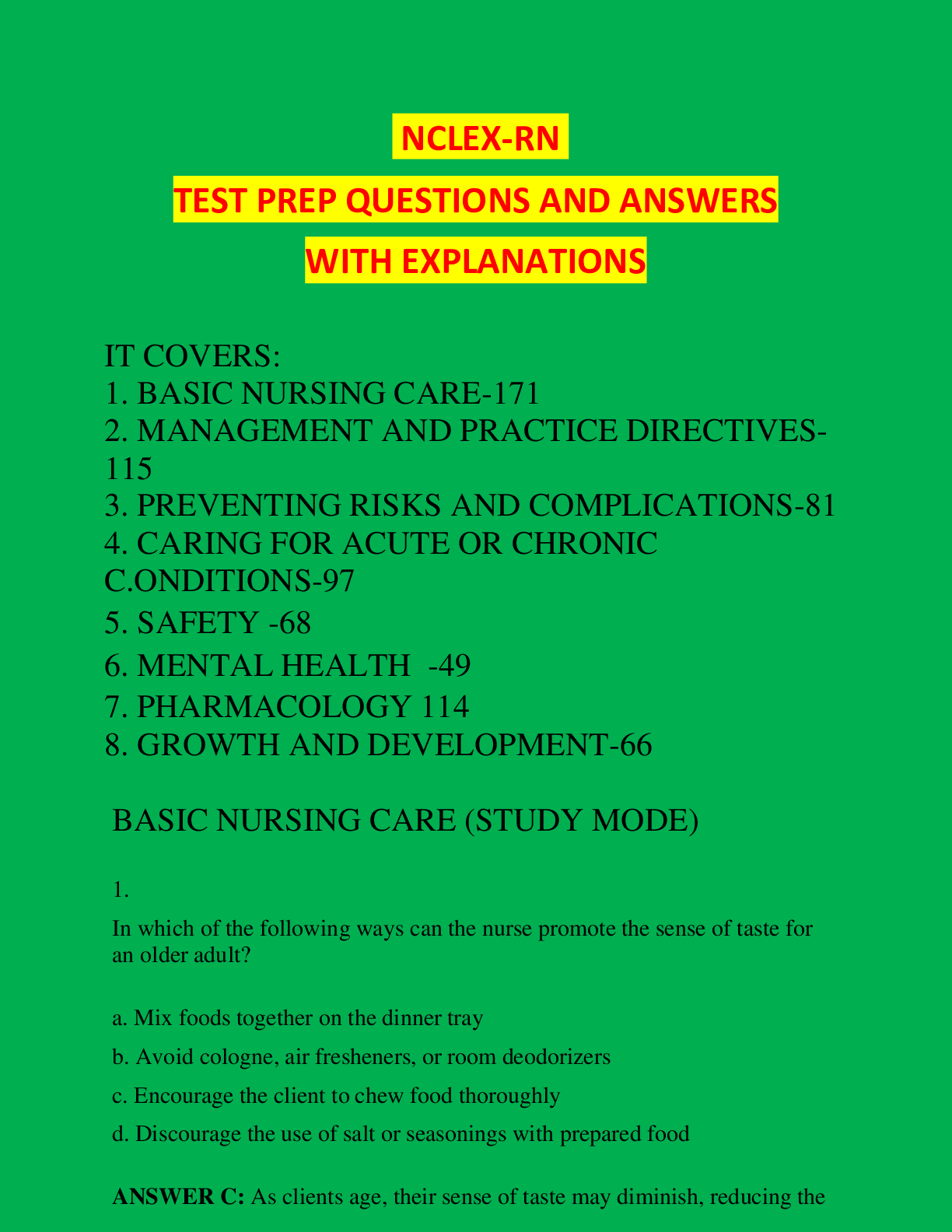*NURSING > NCLEX > NCSBN NCLEX-RN 2018 Examinations. Over 1000 Questions and Answers plus Rationale Helpful to Students (All)
NCSBN NCLEX-RN 2018 Examinations. Over 1000 Questions and Answers plus Rationale Helpful to Students Preparing to Take NCLEX Exams. These Questions are Regularly Repeated.
Document Content and Description Below
SAMPLE QUESTIONS 1. A client with a diagnosis of passive-aggressive personality disorder is seen at the local mental health clinic. A common characteristic of persons with passive-aggressive person... ality disorder is: ❍ A. Superior intelligence ❍ B. Underlying hostility ❍ C. Dependence on others ❍ D. Ability to share feelings 2. The client is admitted for evaluation of aggressive behavior and diagnosed with antisocial personality disorder. A key part of the care of such clients is: ❍ A. Setting realistic limits ❍ B. Encouraging the client to express remorse for behavior ❍ C. Minimizing interactions with other clients ❍ D. Encouraging the client to act out feelings of rage 3. An important intervention in monitoring the dietary compliance of a client with bulimia is: ❍ A. Allowing the client privacy during mealtimes ❍ B. Praising her for eating all her meal ❍ C. Observing her for 1–2 hours after meals ❍ D. Encouraging her to choose foods she likes and to eat in moderation 4. Assuming that all have achieved normal cognitive and emotional development, which of the following children is at greatest risk for accidental poisoning? ❍ A. A 6-month-old ❍ B. A 4-year-old ❍ C. A 12-year-old ❍ D. A 13-year-old5. Which of the following examples represents parallel play? ❍ A. Jenny and Tommy share their toys. ❍ B. Jimmy plays with his car beside Mary, who is playing with her doll. ❍ C. Kevin plays a game of Scrabble with Kathy and Sue. ❍ D. Mary plays with a handheld game while sitting in her mother’s lap. 6. The nurse is ready to begin an exam on a 9-month-old infant. The child is sitting in his mother’s lap. Which should the nurse do first? ❍ A. Check the Babinski reflex ❍ B. Listen to the heart and lung sounds ❍ C. Palpate the abdomen ❍ D. Check tympanic membranes 7. In terms of cognitive development, a 2-year-old would be expected to: ❍ A. Think abstractly ❍ B. Use magical thinking ❍ C. Understand conservation of matter ❍ D. See things from the perspective of others 8. Which of the following best describes the language of a 24-month-old? ❍ A. Doesn’t understand yes and no ❍ B. Understands the meaning of words ❍ C. Able to verbalize needs ❍ D. Asks “why?” to most statements 9. A client who has been receiving urokinase has a large bloody bowel movement. Which action would be best for the nurse to take immediately? ❍ A. Administer vitamin K IM ❍ B. Stop the urokinase ❍ C. Reduce the urokinase and administer heparin ❍ D. Stop the urokinase and call the doctor 2 Chapter 110. The client has a prescription for a calcium carbonate compound to neutralize stomach acid. The nurse should assess the client for: ❍ A. Constipation ❍ B. Hyperphosphatemia ❍ C. Hypomagnesemia ❍ D. Diarrhea 11. Heparin has been ordered for a client with pulmonary embolis. Which statement, if made by the graduate nurse, indicates a lack of understanding of the medication? ❍ A. “I will administer the medication 1-2 inches away from the umbilicus.” ❍ B. “I will administer the medication in the abdomen.” ❍ C. “I will check the PTT before administering the medication.” ❍ D. “I will need to aspirate when I give Heparin.” 12. The nurse is caring for a client with peripheral vascular disease. To correctly assess the oxygen saturation level, the monitor may be placed on the: ❍ A. Hip ❍ B. Ankle ❍ C. Earlobe ❍ D. Chin 13. While caring for a client with hypertension, the nurse notes the following vital signs: BP of 140/20, pulse 120, respirations 36, temperature 100.8°F. The nurse’s initial action should be to: ❍ A. Call the doctor ❍ B. Recheck the vital signs ❍ C. Obtain arterial blood gases ❍ D. Obtain an ECG 14. The nurse is preparing a client with an axillo-popliteal bypass graft for discharge. The client should be taught to avoid: ❍ A. Using a recliner to rest ❍ B. Resting in supine position ❍ C. Sitting in a straight chair ❍ D. Sleeping in right Sim’s position 2018 Exam 1 and Rationales15. The doctor has ordered antithrombolic stockings to be applied to the legs of the client with peripheral vascular disease. The nurse knows antithrombolic stockings should be applied: ❍ A. Before rising in the morning ❍ B. With the client in a standing position ❍ C. After bathing and applying powder ❍ D. Before retiring in the evening 16. The nurse has just received the shift report and is preparing to make rounds. Which client should be seen first? ❍ A. The client with a history of a cerebral aneurysm with an oxygen saturation rate of 99% ❍ B. The client three days post–coronary artery bypass graft with a temperature of 100.2°F ❍ C. The client admitted 1 hour ago with shortness of breath ❍ D. The client being prepared for discharge following a femoral popliteal bypass graft 17. A client with a femoral popliteal bypass graft is assigned to a semiprivate room. The most suitable roommate for this client is the client with: ❍ A. Hypothyroidism ❍ B. Diabetic ulcers ❍ C. Ulcerative colitis ❍ D. Pneumonia 18. The nurse is teaching the client regarding use of sodium warfarin. Which statement made by the client would require further teaching? ❍ A. “I will have blood drawn every month.” ❍ B. “I will assess my skin for a rash.” ❍ C. “I take aspirin for a headache.” ❍ D. “I will use an electric razor to shave.” 19. The client returns to the recovery room following repair of an abdominal aneurysm. Which finding would require further investigation? ❍ A. Pedal pulses regular ❍ B. Urinary output 20mL in the past hour ❍ C. Blood pressure 108/50 ❍ D. Oxygen saturation 97% 4 Chapter 120. The nurse is doing bowel and bladder retraining for the client with paraplegia. Which of the following is not a factor for the nurse to consider? ❍ A. Diet pattern ❍ B. Mobility ❍ C. Fluid intake ❍ D. Sexual function 21. A 20-year-old is admitted to the rehabilitation unit following a motorcycle accident. Which would be the appropriate method for measuring the client for crutches? ❍ A. Measure five finger breadths under the axilla ❍ B. Measure 3 inches under the axilla ❍ C. Measure the client with the elbows flexed 10° ❍ D. Measure the client with the crutches 20 inches from the side of the foot 22. The nurse is caring for the client following a cerebral vascular accident. Which portion of the brain is responsible for taste, smell, and hearing? ❍ A. Occipital ❍ B. Frontal ❍ C. Temporal ❍ D. Parietal 23. The client is admitted to the unit after a motor vehicle accident with a temperature of 102°F rectally. The most likely explanations for the elevated temperature is that: ❍ A. There was damage to the hypothalamus. ❍ B. He has an infection from the abrasions to the head and face. ❍ C. He will require a cooling blanket to decrease the temperature. ❍ D. There was damage to the frontal lobe of the brain. 24. The client is admitted to the hospital in chronic renal failure. A diet low in protein is ordered. The rationale for a low-protein diet is: ❍ A. Protein breaks down into blood urea nitrogen and other waste. ❍ B. High protein increases the sodium and potassium levels. ❍ C. A high-protein diet decreases albumin production. ❍ D. A high-protein diet depletes calcium and phosphorous. 2018 Exam 1 and Rationales 525. The client who is admitted with thrombophlebitis has an order for heparin. The medication should be administered using a/an: ❍ A. Buretrol ❍ B. Infusion controller ❍ C. Intravenous filter ❍ D. Three-way stop-cock 26. The nurse is taking the blood pressure of the obese client. If the blood pressure cuff is too small, the results will be: ❍ A. A false elevation ❍ B. A false low reading ❍ C. A blood pressure reading that is correct ❍ D. A subnormal finding 27. A 4-year-old male is admitted to the unit with nephotic syndrome. He is extremely edematous. To decrease the discomfort associated with scrotal edema, the nurse should: ❍ A. Apply ice to the scrotum ❍ B. Elevate the scrotum on a small pillow ❍ C. Apply heat to the abdominal area ❍ D. Administer an analgesic 28. The client with an abdominal aortic aneurysm is admitted in preparation for surgery. Which of the following should be reported to the doctor? ❍ A. An elevated white blood cell count ❍ B. An abdominal bruit ❍ C. A negative Babinski reflex ❍ D. Pupils that are equal and reactive to light 29. If the nurse is unable to elicit the deep tendon reflexes of the patella, the nurse should ask the client to: ❍ A. Pull against the palms ❍ B. Grimace the facial muscles ❍ C. Cross the legs at the ankles ❍ D. Perform Valsalva maneuver 6 Chapter 130. The physician has ordered atropine sulfate 0.4mg IM before surgery. The medication is supplied in 0.8mg per milliliter. The nurse should administer how many milliliters of the medication? ❍ A. 0.25mL ❍ B. 0.5mL ❍ C. 1.0mL ❍ D. 1.25mL 31. The nurse is evaluating the client’s pulmonary artery pressure. The nurse is aware that this test evaluates: ❍ A. Pressure in the left ventricle ❍ B. The systolic, diastolic, and mean pressure of the pulmonary artery ❍ C. The pressure in the pulmonary veins ❍ D. The pressure in the right ventricle 32. A client is being monitored using a central venous pressure monitor. If the pressure is 2cm of water, the nurse should: ❍ A. Call the doctor immediately ❍ B. Slow the intravenous infusion ❍ C. Listen to the lungs for rales ❍ D. Administer a diuretic 33. The nurse identifies ventricular tachycardia on the heart monitor. The nurse should immediately: ❍ A. Administer atropine sulfate ❍ B. Check the potassium level ❍ C. Prepare to administer an antiarrhythmic such as lidocaine ❍ D. Defibrillate at 360 joules 34. The doctor is preparing to remove chest tubes from the client’s left chest. In preparation for the removal, the nurse should instruct the client to: ❍ A. Breathe normally ❍ B. Hold his breath and bear down ❍ C. Take a deep breath ❍ D. Sneeze on command 2018 Exam 1 and Rationales 735. The doctor has ordered 80mg of furosemide (Lasix) two times per day. The nurse notes the patient’s potassium level to be 2.5meq/L. The nurse should: ❍ A. Administer the Lasix as ordered ❍ B. Administer half the dose ❍ C. Offer the patient a potassium-rich food ❍ D. Withhold the drug and call the doctor 36. Which of the following lab studies should be done periodically if the client is taking warfarin sodium (Coumadin)? ❍ A. Stool specimen for occult blood ❍ B. White blood cell count ❍ C. Blood glucose ❍ D. Erthyrocyte count 37. The client has an order for heparin to prevent post-surgical thrombi. Immediately following a heparin injection, the nurse should: ❍ A. Aspirate for blood ❍ B. Check the pulse rate ❍ C. Massage the site ❍ D. Check the site for bleeding 38. The client with AIDS tells the nurse that he has been using acupuncture to help with his pain. The nurse should question the client regarding this treatment because acupuncture uses: ❍ A. Pressure from the fingers and hands to stimulate the energy points in the body ❍ B. Oils extracted from plants and herbs ❍ C. Needles to stimulate certain points on the body to treat pain ❍ D. Manipulation of the skeletal muscles to relieve stress and pain 39. The nurse is taking the vital signs of the client admitted with cancer of the pancreas. The nurse is aware that the fifth vital sign is: ❍ A. Anorexia ❍ B. Pain ❍ C. Insomnia ❍ D. Fatigue 8 Chapter 140. The 84-year-old male has returned from the recovery room following a total hip repair. He complains of pain and is medicated with morphine sulfate and promethazine. Which medication should be kept available for the client being treated with opoid analgesics? ❍ A. Naloxone (Narcan) ❍ B. Ketorolac (Toradol) ❍ C. Acetylsalicylic acid (aspirin) ❍ D. Atropine sulfate (Atropine) 41. The doctor has ordered a patient-controlled analgesia (PCA) pump for the client with chronic pain. The client asks the nurse if he can become overdosed with pain medication using this machine. The nurse demonstrates understanding of the PCA if she states: ❍ A. “The machine will administer only the amount that you need to control your pain without any action from you.” ❍ B. “The machine has a locking device that prevents overdosing.” ❍ C. The machine will administer one large dose every 4 hours to relieve your pain.” ❍ D. The machine is set to deliver medication only if you need it.” 42. The doctor has ordered a Transcutaneous Electrical Nerve Stimulation (TENS) unit for the client with chronic back pain. The nurse teaching the client with a TENS unit should tell the client: ❍ A. “You may be electrocuted if you use water with this unit.” ❍ B. “Please report skin irritation to the doctor.” ❍ C. “The unit may be used anywhere on the body without fear of adverse reactions.” ❍ D. “A cream should be applied to the skin before applying the unit.” 43. The nurse asked the client if he has an advance directive. The reason for asking the client this question is: ❍ A. She is curious about his plans regarding funeral arrangements. ❍ B. Much confusion can occur with the client’s family if he does not have an advanced directive. ❍ C. An advanced directive allows the medical personnel to make decisions for the client. ❍ D. An advanced directive allows active euthanasia to be carried out if the client is unable to care for himself. 2018 Exam 1 and Rationales 9 ✓44. A client who has chosen to breastfeed tells the nurse that her nipples became very sore while she was breastfeeding her older child. Which measure will help her to avoid soreness of the nipples? ❍ A. Feeding the baby during the first 48 hours after delivery ❍ B. Breaking suction by placing a finger between the baby’s mouth and the breast when she terminates the feeding ❍ C. Applying hot, moist soaks to the breast several times per day ❍ D. Wearing a support bra 45. The nurse is performing an assessment of an elderly client with a total hip repair. Based on this assessment, the nurse decides to medicate the client with an analgesic. Which finding most likely prompted the nurse to decide to administer the analgesic? ❍ A. The client’s blood pressure is 130/86. ❍ B. The client is unable to concentrate. ❍ C. The client’s pupils are dilated. ❍ D. The client grimaces during care. 46. An obstetrical client decides to have an epidural anesthetic to relieve pain during labor. Following administration of the anesthesia, the nurse should monitor the client for: ❍ A. Seizures ❍ B. Postural hypertension ❍ C. Respiratory depression ❍ D. Hematuria 47. The nurse is assessing the client admitted for possible oral cancer. The nurse identifies which of the following to be a late-occurring symptom of oral cancer? ❍ A. Warmth ❍ B. Odor ❍ C. Pain ❍ D. Ulcer with flat edges 48. The nurse understands that the diagnosis of oral cancer is confirmed with: ❍ A. Biopsy ❍ B. Gram Stain ❍ C. Oral culture ❍ D. Oral washings for cytology 10 Chapter 149. The nurse is caring for the patient following removal of a large posterior oral lesion. The priority nursing measure would be to: ❍ A. Maintain a patent airway ❍ B. Perform meticulous oral care every 2 hours ❍ C. Ensure that the incisional area is kept as dry as possible ❍ D. Assess the client frequently for pain 50. The registered nurse is conducting an in-service for colleagues on the subject of peptic ulcers. The nurse would be correct in identifying which of the following as a causative factor? ❍ A. N. gonorrhea ❍ B. H. influenza ❍ C. H. pylori ❍ D. E. coli 51. The patient states, “My stomach hurts about 2 hours after I eat.” Based upon this information, the nurse suspects the patient likely has a: ❍ A. Gastric ulcer ❍ B. Duodenal ulcer ❍ C. Peptic ulcer ❍ D. Curling’s ulcer 52. The nurse is caring for a patient with suspected diverticulitis. The nurse would be most prudent in questioning which of the following diagnostic tests? ❍ A. Abdominal ultrasound ❍ B. Barium enema ❍ C. Complete blood count ❍ D. Computed tomography (CT) scan 53. The nurse is planning care for the patient with celiac disease. In teaching about the diet, the nurse should instruct the patient to avoid which of the following for breakfast? ❍ A. Puffed wheat ❍ B. Banana ❍ C. Puffed rice ❍ D. Cornflakes 2018 Exam 1 and Rationales 1154. The nurse is teaching about irritable bowel syndrome (IBS). Which of the following would be most important? ❍ A. Reinforcing the need for a balanced diet ❍ B. Encouraging the client to drink 16 ounces of fluid with each meal ❍ C. Telling the client to eat a diet low in fiber ❍ D. Instructing the client to limit his intake of fruits and vegetables 55. In planning care for the patient with ulcerative colitis, the nurse identifies which nursing diagnosis as a priority? ❍ A. Anxiety ❍ B. Impaired skin integrity ❍ C. Fluid volume deficit ❍ D. Nutrition altered, less than body requirements 56. The patient is prescribed metronidazole (Flagyl) for adjunct treatment for a duodenal ulcer. When teaching about this medication, the nurse would include: ❍ A. “This medication should be taken only until you begin to feel better.” ❍ B. “This medication should be taken on an empty stomach to increase absorption.” ❍ C. “While taking this medication, you do not have to be concerned about being in the sun.” ❍ D. “While taking this medication, alcoholic beverages and products containing alcohol should be avoided.” 57. The nurse is preparing to administer a feeding via a nasogastric tube. The nurse would perform which of the following before initiating the feeding? ❍ A. Assess for tube placement by aspirating stomach content ❍ B. Place the patient in a left-lying position ❍ C. Administer feeding with 50% Dextrose ❍ D. Ensure that the feeding solution has been warmed in a microwave for 2 minutes 12 Chapter 158. Which is true regarding the administration of antacids? ❍ A. Antacids should be administered without regard to mealtimes. ❍ B. Antacids should be administered with each meal and snack of the day. ❍ C. Antacids should not be administered with other medications. ❍ D. Antacids should be administered with all other medications, for maximal absorption. 59. The nurse is caring for a patient with a colostomy. The patient asks, “Will I ever be able to swim again?” The nurse’s best response would be: ❍ A. “Yes, you should be able to swim again, even with the colostomy.” ❍ B. “You should avoid immersing the colostomy in water.” ❍ C. “No, you should avoid getting the colostomy wet.” ❍ D. “Don’t worry about that. You will be able to live just like you did before.” 60. The nurse is assisting in the care of a patient who is 2 days post-operative from a hemorroidectomy. The nurse would be correct in instructing the patient to: ❍ A. Avoid a high-fiber diet ❍ B. Continue to use ice packs ❍ C. Take a laxative daily to prevent constipation ❍ D. Use a sitz bath after each bowel movement 61. The nurse is assisting in the care of a client with diverticulosis. Which of the following assessment findings must necessitate an immediate report to the doctor? ❍ A. Bowel sounds are present ❍ B. Intermittent left lower-quadrant pain ❍ C. Constipation alternating with diarrhea ❍ D. Hemoglobin 26% and hematocrit 32 62. The client is newly diagnosed with juvenile onset diabetes. Which of the following nursing diagnoses is a priority? ❍ A. Anxiety ❍ B. Pain ❍ C. Knowledge deficit ❍ D. Altered thought process 2018 Exam 1 and Rationales 1363. The nurse is asked by the nurse aide, “Are peptic ulcers really caused by stress?” The nurse would be correct in replying with the following: ❍ A. “Peptic ulcers result from overeating fatty foods.” ❍ B. “Peptic ulcers are always caused from exposure to continual stress.” ❍ C. “Peptic ulcers are like all other ulcers, which all result from stress.” ❍ D. “Peptic ulcers are associated with H. pylori, although there are other ulcers that are associated with stress.” 64. The nurse is assisting in the assessment of the patient admitted with “extreme abdominal pain.” The nurse asks the client about the medication that he has been taking because: ❍ A. Interactions between medications will cause abdominal pain. ❍ B. Various medications taken by mouth can affect the alimentary tract. ❍ C. This will provide an opportunity to educate the patient regarding the medications used. ❍ D. The types of medications might be attributable to an abdominal pathology not already identified. 65. The nurse is assessing the abdomen. The nurse knows the best sequence to perform the assessment is: ❍ A. Inspection, auscultation, palpation ❍ B. Auscultation, palpation, inspection ❍ C. Palpation, inspection, auscultation ❍ D. Inspection, palpation, auscultation 66. The nurse is caring for the client who has been in a coma for 2 months. He has signed a donor card, but the wife is opposed to the idea of organ donation. How should the nurse handle the topic of organ donation with the wife? ❍ A. Tell the wife that the hospital will honor her wishes regarding organ donation, but contact the organ-retrieval staff ❍ B. Tell her that because her husband signed a donor card, the hospital has the right to take the organs upon the death of her husband ❍ C. Explain that it is necessary for her to donate her husband’s organs because he signed the permit ❍ D. Refrain from talking about the subject until after the death of her husband 14 Chapter 167. The client with cancer refuses to care for herself. Which action by the nurse would be best? ❍ A. Alternate nurses caring for the client so that the staff will not get tired of caring for this client ❍ B. Talk to the client and explain the need for self-care ❍ C. Explore the reason for the lack of motivation seen in the client ❍ D. Talk to the doctor about the client’s lack of motivation 68. The charge nurse is making assignments for the day. After accepting the assignment to a client with leukemia, the nurse tells the charge nurse that her child has chickenpox. Which initial action should the charge nurse take? ❍ A. Change the nurse’s assignment to another client ❍ B. Explain to the nurse that there is no risk to the client ❍ C. Ask the nurse if the chickenpox have scabbed ❍ D. Ask the nurse if she has ever had the chickenpox 69. The nurse is caring for the client with a mastectomy. Which action would be contraindicated? ❍ A. Taking the blood pressure in the side of the mastectomy ❍ B. Elevating the arm on the side of the mastectomy ❍ C. Positioning the client on the unaffected side ❍ D. Performing a dextrostix on the unaffected side 70. The client has an order for gentamycin to be administered. Which lab results should be reported to the doctor before beginning the medication? ❍ A. Hematocrit ❍ B. Creatinine ❍ C. White blood cell count ❍ D. Erythrocyte count 71. Which of the following is the best indicator of the diagnosis of HIV? ❍ A. White blood cell count ❍ B. ELISA ❍ C. Western Blot ❍ D. Complete blood count 2018 Exam 1 and Rationales 15 ✓72. The client presents to the emergency room with a “bull’s eye” rash. Which question would be most appropriate for the nurse to ask the client? ❍ A. “Have you found any ticks on your body?” ❍ B. “Have you had any nausea in the last 24 hours?” ❍ C. “Have you been outside the country in the last 6 months?” ❍ D. “Have you had any fever for the past few days?” 73. Which client should be assigned to the nursing assistant? ❍ A. The 18-year-old with a fracture to two cervical vertebrae ❍ B. The infant with meningitis ❍ C. The elderly client with a thyroidectomy 4 days ago ❍ D. The client with a thoracotomy 2 days ago 74. The client presents to the emergency room with a hyphema. Which action by the nurse would be best? ❍ A. Elevate the head of the bed and apply ice to the eye ❍ B. Place the client in a supine position and apply heat to the knee ❍ C. Insert a Foley catheter and measure the intake and output ❍ D. Perform a vaginal exam and check for a discharge 75. The client has an order for FeSo 4 liquid. Which method of administration would be best? ❍ A. Administer the medication with milk ❍ B. Administer the medication with a meal ❍ C. Administer the medication with orange juice ❍ D. Administer the medication undiluted 76. The client with an ileostomy is being discharged. Which teaching should be included in the plan of care? ❍ A. Using Karaya powder to seal the bag. ❍ B. Irrigating the ileostomy daily. ❍ C. Using stomahesive as the best skin protector. ❍ D. Using Neosporin ointment to protect the skin. 77. Vitamin K is administered to the newborn shortly after birth for which of the following reasons? ❍ A. To stop hemorrhage ❍ B. To treat infection ❍ C. To replace electrolytes ❍ D. To facilitate clotting 16 Chapter 178. Before administering Methyltrexate orally to the client with cancer, the nurse should check the: ❍ A. IV site ❍ B. Electrolytes ❍ C. Blood gases ❍ D. Vital signs 79. The nurse is teaching a group of new graduates about the safety needs of the client receiving chemotherapy. Before administering chemotherapy, the nurse should: ❍ A. Administer a bolus of IV fluid ❍ B. Administer pain medication ❍ C. Administer an antiemetic ❍ D. Allow the patient a chance to eat 80. The client is admitted to the postpartum unit with an order to continue the infusion of Pitocin. The nurse is aware that Pitocin is working if the fundus is: ❍ A. Deviated to the left. ❍ B. Firm and in the midline. ❍ C. Boggy. ❍ D. Two finger breadths below the umbilicus. 81. A 5-year-old is a family contact to the client with tuberculosis. Isoniazid (INH) has been prescribed for the client. The nurse is aware that the length of time that the medication will be taken is: ❍ A. 6 months ❍ B. 3 months ❍ C. 1 year ❍ D. 2 years 82. A 4-year-old with cystic fibrosis has a prescription for Viokase pancreatic enzymes to prevent malabsorption. The correct time to give pancreatic enzyme is: ❍ A. 1 hour before meals ❍ B. 2 hours after meals ❍ C. With each meal and snack ❍ D. On an empty stomach [Show More]
Last updated: 1 year ago
Preview 1 out of 403 pages

Reviews( 0 )
Document information
Connected school, study & course
About the document
Uploaded On
Nov 11, 2021
Number of pages
403
Written in
Additional information
This document has been written for:
Uploaded
Nov 11, 2021
Downloads
1
Views
154


